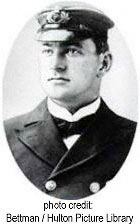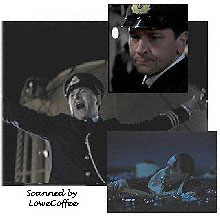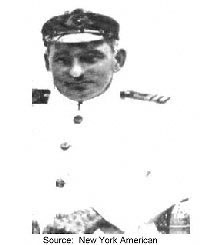
Copyright 1998 Christine Ehren.
 |
September 21, 1872 - April 15, 1912 Age at time of disaster: 39 Birthplace: Liverpool, England 1912 Residence: Liverpool, England Salary/Month: 25.00.00 (in English pounds) Berth before Titanic: Olympic, Chief Officer Description: "Henry Tingle Wilde was not considered a man given to flights of fancy. A tall, powerfully built man, just thirty-eight, he too had worked his ranks from a ship's apprentice in the old square-rigged ships, through the ranks until his appointment as chief officer of the Olympic in May 1911. The White Star Line's management held him in high regard, and Captain Smith valued his skill and experience." (Daniel Allen Butler, "Unsinkable" The Full Story of the RMS Titanic, page 52) |  Mark Lindsay Chapman portrays Officer Wilde in James Cameron's Titanic |
| Quote: "I still don't like this ship . . . I have a queer feeling about it." (From a letter to his sister, posted at Queenstown, Ireland, April 11, 1912) |
Henry Tingle Wilde
Wilde Card--Did Wilde shoot himself April 15, 1912?
Wilde After Death--Portrayals of the Chief Officer
Acknowlegments/Sources
|
It was early on the fair morning of April 10, when chief officer Henry Tingle Wilde found himself up and working on what was going to be his ship. After spending the night aboard running shifts with the other officers, he assumed his post as chief officer on Titanic on sailing day. He'd known for a few days that this was going to be his position and he'd debated about taking it. But he'd been urged to and so he took it, although reluctantly. "I still don't like this ship...I have a queer feeling about it," he would write to his sister from Queenstown. His addition was meant to add experience to the ship. Smith requested Wilde for Titanic's chief for the high profile maiden voyage. His addition, however, had also shuffled the senior officers--moving William Murdoch down to first officer, Charles Lightoller down to second officer, and moving David Blair off ship entirely. The arrangement would only last for one crossing--to New York and back again. At 7:30AM on April 10, Wilde delivered the sailing report to Captain Smith. At 8AM, there was the Board of Trade muster, called by the chief officer, where all the members of the crew had to be present. This muster included an inspection by the officers and a boat drill. The boat drill was led by Fifth Officer Harold Lowe and Sixth Officer James Moody.
At noon, they launched, heading for Cherbourg, France. Titanic had begun her maiden voyage.
Wilde was married before 1900 to Mary Catherine Jones, who was a few years older than him. With her, he fathered six children. Two of them, twin boys, Archie and Richard, died in infancy and Mary Catherine passed away soon after on December 24, 1910 from complications in childbirth. Wilde apprenticed on the sailing ships of James Chambers, then transferred to the Maranhan Steamship Company after obtaining his second mates certificate. Shortly after earning his master's certificate (#024371), Wilde left Maranhan and joined White Star. With his new line, Wilde served the North Atlantic and Australian routes, sailing with Arabic (Boston run, passenger ship, June-October 1905), Celtic (2nd Celtic, one of the "Big Four", December 1905-April 1906), Medic (passenger ship, September 1906-April 1908), and Cymric (passenger ship, June-September, 1908). In only four years, Wilde became the chief officer of White Star's largest vessel, the Olympic--largest, until her sister ship, Titanic was ready to launch. Wilde was chief (but not in command) on September 11, 1911 when the Olympic, on its fifth voyage, collided with the HMS Hawke. The accident left two gashes in the starboard rear side of the Olympic, one above the water line and one below. The starboard propeller was also badly damaged.
In the following court case, Olympic was held totally responsible for the damages, the tribunal blaming the ship's wake for having pulled the Hawke off course and into the hull of the Olympic. This same force would be seen again when the New York almost collided with the Titanic on April 10. This second time, Smith avoided an accident.
On April 14, the lifeboat drill was forgone. Wilde came on at 2PM and was relieved by Lightoller at 6PM. "It's rather colder than usual," Wilde commented. Lightoller agreed. Later, the second officer would have the ship's carpenter check the fresh water supply and talk with Murdoch about the fact that it was freezing cold. Where Wilde was when the ship struck the iceberg was not recorded but he appeared on the bridge, asking the Captain, "Is it serious?" "Certainly. It is more than serious," Smith answered. Wilde was then either ordered to or willingly joined the ship inspection that included Fourth Officer Joseph Boxhall and the ship's builder, Thomas Andrews. It was on this inspection that trimmer Samuel Hemming told Wilde of the air escaping in the forepeak tank. Wilde had put his head around the hawse pipe and asked, "What is that, Hemming?" Hemming explained there was air escaping, but that the storeroom was still dry. Also, it appears some stokers from D deck made their way to the boat deck, wearing life belts and in a panic. Fireman John Thompson reported that when they reached the deck, the chief officer demanded, "What in the hell are you doing up here?" He sent them back down again. Wilde saw to the uncovering of the boats, while Murdoch roused the passengers. Wilde was left generally in charge of loading the lifeboats, but he didn't move fast enough for Lightoller. When he asked for permission to swing out the boats, Wilde told him to wait. Lightoller went to the bridge and asked Captain Smith for permission. Smith granted it and Lightoller swung out the boats. Then Lightoller asked if he could begin loading the boats. Again, Wilde told him to wait and again Lightoller went to the bridge to get Smith's permission. Again, Smith granted it with "Yes, put the women and children in and lower away." That adage was strictly adhered to on the port side, where Wilde participated most in the loading. The first boat to go on the port side was either 8 or 6--the official British "Report on the Loss of the Titanic (S.O.S)" states 6 lowered at 12:55 was the first--Archibald Gracie, who did much painstaking research on the events of April 14-15, believed that Lightoller's testimony pointed to 8 as the first boat to go. The official "Report" lists 8 as loaded by Wilde. Witnesses Seaman T. Jones and Steward A. Crawford both said Smith ordered them in. After the loading of boat 6 by Lightoller, Wilde approached the second officer. "Do you know where the firearms are?" Lightoller knew that it was the first officer's responsibility to receive firearms and he himself, as first officer, had taken the guns and locked them away in a locker in the first officer's cabin. Wilde may have known something of this as he asked Lightoller, not Murdoch. Lightoller answered that he knew where they were and he, Wilde, Smith, and Murdoch proceeded to the first officer's cabin. The locker was opened and out came the pistols. Each officer ended up with one--although, in his own account, Lightoller claims Wilde "shoved one of the revolvers" and some ammunition into his hand as he was leaving. "You may need it," Wilde told him. At 1:20AM, Boat 10 was the next to leave on the port side, loaded by Wilde (with Lightoller and Moody?). The chief officer, searching for crew, asked Able Seaman Edward Buley what he did. When Buley answered that he was seaman, Wilde told him to find a second sailor to assist in the boat. Buley found his friend, Fredrick Evans, and Wilde ordered both men into the boat. Evans stood in the bow of boat 10 as the chief officer and ships's baker Joughin "chucked" children in and made women jump a gap of two and one half feet. When the boat contained 35 people, Wilde ordered it lowered. As women were passed to them, Joughin heard Wilde shout for the stewards to keep the men back, but he saw no reason for the order. The men were keeping back. The next boat to fill was number 12, loaded by Lightoller and F. Clench. It was filled with women and children that Clench reported were passed onto them by the chief officer. Boat 10 was then loaded and Clench returned to boat 12 (while 10 was lowered). "How many men have you in this boat?" Wilde asked. "Only one, sir," Clench answered. Able seaman Poigndestre had been placed in charge of 12. "Jump into that boat," Wilde ordered. Clench obeyed and was saved. Boat 2, lowered at 1:45, contained only 18 people and was loaded by Lightoller, who stood partially in the boat to assist the ladies in crossing over a high bulwark rail. Wilde saw there were no seamen available and Lightoller already standing in the boat. "You go with her, Lightoller," he said. "Not damn likely," Lightoller shot back. Wilde's reaction to Lightoller's insubordination was not recorded. Fourth officer Joseph Boxhall was sent in charge instead. Seaman Frank Osman reported that the chief officer loaded the emergency boat with 25 people, including four crewmen and a third class male passenger. On the starboard side, Wilde assisted with the loading of Engelhardt boat C, lowered at 1:40AM. Wilde called for a sailor and Captain Smith ordered Quartermaster George Rowe into the boat. Wilde called, "Are there any more women and children?" There was no reply. As there were still empty places in the boat, both White Star Line president J. Bruce Ismay and Mr. William Carter slipped into the boat before it was lowered. Rowe testifed that noone asked them into the boat nor did Wilde order them into the boat. Wilde may have been at boat A or B when the "great wave" struck the boat, sweeping crew and passengers off the deck. Henry Tingle Wilde died on board or in the water on April 15, 1912. What happened to him in the end is unknown. His body was never recovered. Wilde's grave, although empty, is located next to his wife's. In 1910, when he buried her, his Royal Navy ranking was listed as lieutenant. In 1912, his tomb was marked with Captain--R.N.R. The Titanic Relief Fund provided a stipend for Wilde's children. Mrs. Smith, Captain Smith's wife, later requested these payments be increased. Today, even in his home town, Wilde is relatively unknown. In the February 24, 1998 Titanic supplement of the Liverpool Echo, Wilde only warrants a small mention: “Liverpool’s forgotten hero, Chief Officer Henry Wilde, was hauled up from obscurity in 1996. Officer Wilde, from Walton, flits through the enquiry evidence but witnesses have described how Wilde supervised the loading of the lifeboats and stopped 100 people rushing them by the sheer force of his personality. He is believed to have prevented a panic which would have led to even greater losses.” Wilde Card--Did Wilde shoot himself April 15, 1912? "While the last boat was leaving, I saw an officer with a revolver fire a shot and kill a man who was trying to climb into it. As there remained nothing else for him to, the officer told us, "Gentlemen, each man for himself. Good bye." He gave a military salute and then fired a bullet into his head. That's what I call a man!" A letter dated April 19, 1912 from George Rheims, who survived on collapsible A (translated French from Walter Lord's The Night Lives On) Was it First Officer Murdoch who pulled the trigger as is so often depicted and accepted--or was it Chief Officer Wilde? The crew seemed confused enough about which officer was which. Seamen Buley and Evans who loaded boat 10 with Wilde referred to him as Chief Officer Murdoch, as seaman Osman, in the loading of boat 2, reported Murdoch ordered him in. The crew knew his rank, but not his name--after all, wasn't Murdoch their chief until April 10th? What's lacking is a strong motive. There are possiblities--Wilde may have felt unwelcome on the ship. He was the last minute usurper and it's obvious that Lightoller didn't take to him. First Officer Murdoch, the man Wilde replaced, however, knew and had served under the chief officer on the Olympic. Both had served under Captain Smith--and it must have be stressful--this arrangement of officers was only for one voyage. Wilde was also uncomfortable with the ship itself as evidenced in his letter to his sister. He reluctantly took the assignment through the urging of his family, perhaps with the suggestion that soon enough he would be made a captain himself. Finally, there is the persistent, but unverified rumor that Wilde had recently lost part of his family to scarlet fever and that the stress of this had driven him to suicide. Wilde had suffered a harsh personal tragedy on December 24, 1910 when his wife, Mary Catherine, passed away from complications in childbirth. Their twin sons, Archie and Richard, also died. The possibility that this could have suddenly driven him suicidal--a year and a half later--seems unlikely. Wilde had four surviving children ages 3 to 12 at home. He was most likely about to receive a promotion. Wilde had plenty to live for. Could it have been "noble suicide"--of the kind that caused Rheims to exclaim, "That's what I call a man."? The noble suicide ideal was not dead in Edwardian England. The post-modern belief in wasted, senseless life was still a world war away. The theory of Wilde "manfully" taking his own life is possible, but doesn't single him out over Murdoch or Purser McElroy as the suicide. Of course, it's also possible that no suicide took place at all. Lightoller didn't believe one had and neither did Archibald Gracie. Both men were within earshot of Murdoch--and Wilde--in the loading of the final collapsibles. Gracie described Wilde's end: "Clinch Smith and I got away from this point just before the water reached it and drowned Chief Officer Wilde and First Officer Murdoch and others who were not successful in effecting a lodgement on the boat as it was swept off the deck." Perhaps Wilde even approached Collapsible B. Jack Thayer heard the call go around, "Is the Chief aboard?" He didn't know who that meant--Wilde, Smith, or Bell. "I do know that one of the circular life rings from the bridge was there when we got off in the morning. It may be that Captain Smith was aboard with us for awhile. Nobody knew where the "Chief" was," Thayer wrote. Wilde After Death--Portrayals of the Chief Officer The James Cameron Titanic most promently features Wilde, played by Mark Lindsay Chapman. This Wilde seems to more or less accurately follow his historical model, although he doesn't make an appearance in the film until he shows up behind Murdoch as Smith asks how many souls are aboard. He is also shown following Boxhall, Andrews, and the Captain as Boxhall gives the damage report. Wilde leads the uncovering of the boats and explains to Andrews that noone will come outside to be loaded because it's too damn cold and noisy. In the actual loading of the boats, Wilde is the officer in charge of the lowering of the boat Rose (Kate Winslet) first gets into (he's the officer waving his arms in slow motion). Wilde is also the officer loading with Murdoch (Ewan Stewart) when the final panic begins and Murdoch shoots two passengers--and then himself. Wilde shouts, "Don't, Will." But too late. Cal (Billy Zane) then approaches Wilde with the child in his arms and Wilde lets him through. As the water rushes up on to the last two boats, Wilde screams for the crew to cut the falls on collapsible A, then grabs a knife to help. He can be seen holding his pistol butt first. In the water, Wilde floats on a deck chair (he appears to not be wearing a life preserver?) and blows his officer's whistle, calling for the others to "Return the boats". He is unheeded (and most likely unheard) and meets his end in the water, clutching his deck chair. Rose removes the whistle from his mouth and calls Lowe's attention. In this version, even in death, Wilde proves useful. Most versions of the Titanic story choose to ignore Wilde. Only two other version mention him--the 1953 20th Century Fox movie, Titanic, had an uncredited Charles Fitzsimmons playing Wilde and the 1979 TV movie, S.O.S. Titanic, featured Tony Caunter as Wilde. Most interpretations don't go to the effort of the 1996 CBS mini-series, where Murdoch wears three stripes, instead of two, marking him as chief officer. They quietly forget Wilde instead, never explaining the jump in stripes from Murdoch's two to Smith's four.
Contributing L/F writer: Christine Ehren © 1998. The information presented here may not under any circumstances be resold or redistributed without prior written permission from the respective authors. Please respect our copyrights. |
|
Acknowledgements and Sources Susanne Stormer Michael Findlay Geoff Whitfield for the information they've passed along about the chief. |  |